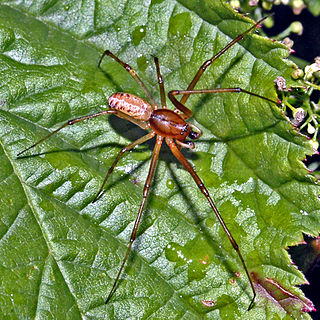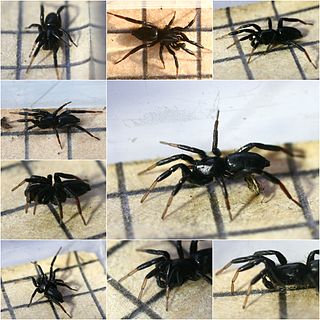
Ground spiders comprise Gnaphosidae, the seventh largest spider family with over 2,000 described species in over 100 genera distributed worldwide. There are 105 species known to central Europe, and common genera include Gnaphosa, Drassodes, Micaria, Cesonia, Zelotes and many others. They are closely related to Clubionidae. At present, no ground spiders are known to be seriously venomous to humans.

Zodarion is a genus of ant-eating spiders from the family Zodariidae. 169 species from Eurasia, North Africa and North America have been described as of November 2022.

Aelurillus is a genus of spiders in the family Salticidae.

Saitis is a genus of jumping spiders that was first described by Eugène Louis Simon in 1876. The Australian species may belong to other genera, such as Maratus.

Drassodes is a genus of ground spiders that was first described by Niklas Westring in 1851. They are brown, gray, and red spiders that live under rocks or bark in mostly dry habitats, and are generally 3.8 to 11.6 millimetres long, but can reach up to 20 millimetres (0.79 in) in length.

Dysdera is a genus of woodlouse hunting spiders that was first described by Pierre André Latreille in 1804. They originated from Central Asia to Central Europe.

Zelotes is a genus of ground spiders that was first described by J. Gistel in 1848.

Harpactea is a genus of woodlouse hunting spiders that was first described by W. S. Bristowe in 1939. They are non-web building predators that forage on the ground and on tree trunks at night, mainly in xerothermic forests. During the day, they hide in silk retreats they build under rocks or bark.

Hoplopholcus is a genus of cellar spiders that was first described by Władysław Kulczyński in 1908.

Linyphia is a genus of dwarf spiders that was first described by Pierre André Latreille in 1804. The name is Greek, and means "thread-weaver" or "linen maker".

Chaetopelma is a genus of tarantulas that was first described by Anton Ausserer in 1871. They are found in Africa and Asia including the countries of Turkey, Syria, Egypt, Cyprus, Greece, Sudan, Cameroon, and now even Iran.

Scotophaeus is a genus of ground spiders that was first described by Eugène Simon in 1893.
Stalagtia is a genus of woodlouse hunting spiders that was first described by J. Kratochvíl in 1970.
Cryptodrassus is a genus of ground spiders that was first described by F. Miller in 1943.

Drassyllus is a genus of ground spiders that was first described by R. V. Chamberlin in 1922.
Leptopilos is a genus of ground spiders that was first described by G. Levy in 2009.

Nomisia is a genus of ground spiders that was first described by R. de Dalmas in 1921.
Zagrotes is a genus of Iranian ground spiders, first described by Alireza Zamani, Maria Chatzaki, Sergei L. Esyunin and Yuri M. Marusik in 2021.













